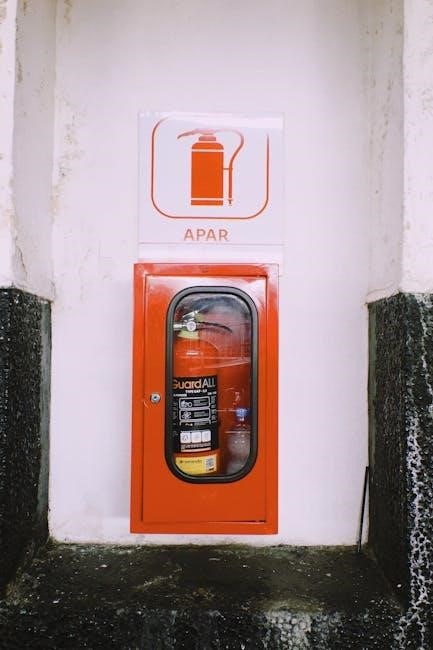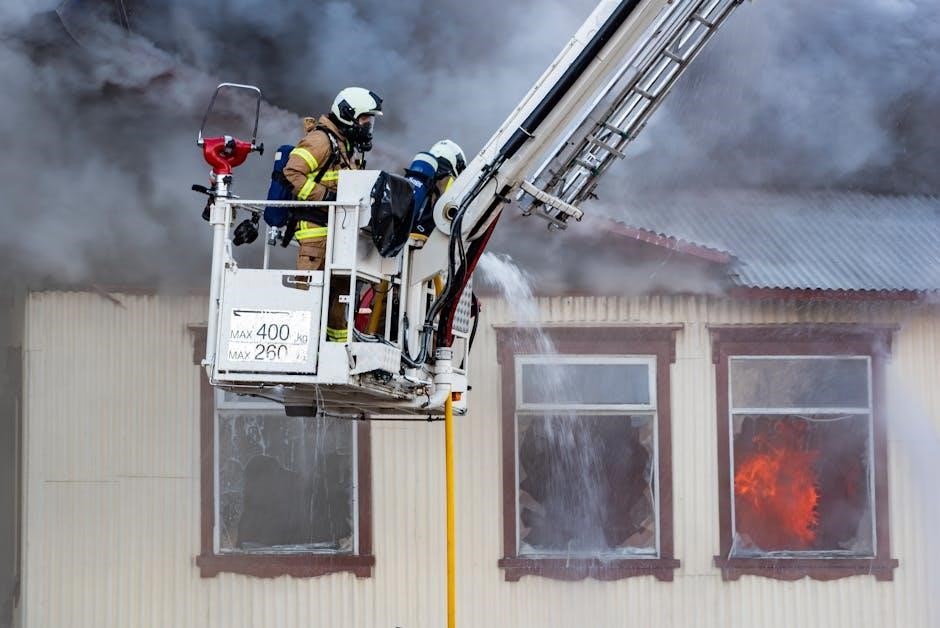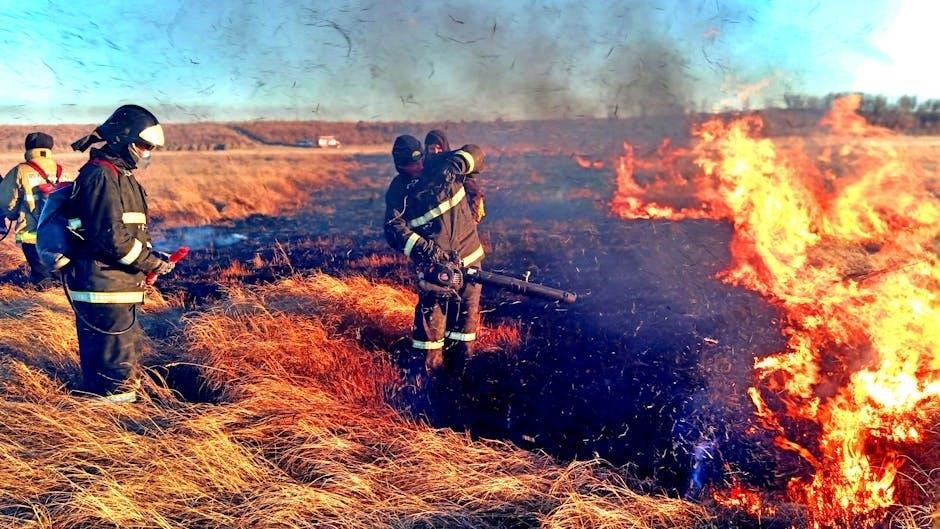NFPA Fire Protection Guide to Hazardous Materials: Overview
The NFPA Fire Protection Guide to Hazardous Materials is a crucial resource. It offers extensive data for safe chemical handling‚ storage‚ and transportation. Firefighters and emergency responders use it to prevent emergencies and make informed decisions during chemical incidents.
Purpose and Scope of the Guide

The primary purpose of the NFPA Fire Protection Guide to Hazardous Materials is to provide comprehensive information on the properties and hazards of various chemicals. This facilitates informed decision-making during emergencies. The scope includes guidance on safe storage‚ handling‚ and transportation practices. Furthermore‚ it aids in developing effective fire prevention and emergency response plans. It is valuable for firefighters‚ emergency responders‚ and anyone involved in managing hazardous materials. The guide helps mitigate risks and protect life and property from chemical-related incidents‚ ensuring safer handling and response procedures.

Hazardous Materials Definition
Hazardous materials‚ as defined in the guide‚ encompass substances that pose risks to people‚ the environment‚ or property. These include solids‚ liquids‚ or gases. When released‚ they can cause harm necessitating careful handling and emergency response.
NFPA 472 Definition
According to NFPA 472‚ a hazardous material is any substance‚ whether solid‚ liquid‚ or gas‚ capable of causing harm to people‚ the environment‚ or property upon release. This definition extends to weapons of mass destruction. The standard emphasizes competence for responders to hazardous materials incidents. It is crucial for understanding the scope and potential dangers associated with various hazardous substances‚ ensuring effective emergency response and mitigation strategies are implemented to protect life and property from these threats.

Key NFPA Standards Included
The guide incorporates several key NFPA standards. These standards provide vital data and practices for hazardous materials; NFPA 49‚ 325‚ 491‚ and 704 are among those included. These offer comprehensive information and guidance.
NFPA 49: Hazardous Chemicals Data Compilation
NFPA 49 is a crucial component within the Fire Protection Guide. It offers compiled data regarding hazardous chemicals. This compilation is essential for understanding the properties and potential hazards associated with various chemicals. The data aids in safe handling‚ storage‚ and emergency response. It helps in preventing fires and mitigating risks effectively. This compilation supports informed decision-making for professionals dealing with hazardous materials‚ enhancing safety protocols and emergency preparedness.
NFPA 325: Fire Hazard Properties of Flammable Liquids‚ Gases‚ and Volatile Solids
NFPA 325 is a standard focusing on the fire hazard properties. It covers flammable liquids‚ gases‚ and volatile solids. This standard provides critical data for understanding their fire-related risks. It aids in implementing appropriate safety measures. The information is vital for preventing fires and explosions. Emergency responders rely on it for safe handling and firefighting strategies. This standard ensures better safety practices. It minimizes risks associated with these hazardous materials.
NFPA 491: Compilation of Hazardous Chemical Reactions
NFPA 491 is a comprehensive compilation. It details hazardous chemical reactions. This standard provides critical information. It helps to understand potential dangers. It covers reactions that can lead to fires or explosions. Emergency responders rely on it during incidents. It assists in predicting and preventing dangerous outcomes. Chemical safety professionals utilize it for risk assessment. It aids in developing safe handling procedures. This compilation enhances safety in chemical environments. Proper use minimizes the risk of unintended reactions.
NFPA 704: Standard System for the Identification of the Hazards of Materials for Emergency Response
NFPA 704 is a vital standard. It offers a clear system for identifying hazards. It uses a diamond-shaped symbol. The symbol communicates risks quickly. It includes health‚ flammability‚ instability‚ and special hazards. Emergency responders use this system for rapid assessment. It allows them to understand potential dangers immediately. Workers and the public benefit from this clear warning system. It promotes safety by providing easily understood hazard information. The system aids in planning appropriate responses to emergencies. It supports safer handling and storage practices for hazardous materials. It is an essential tool for hazard communication.

Applications of the Guide
This guide is essential for emergency response. It aids in chemical safety. It assists in mitigating risks. It supports informed decision-making. It promotes safe handling practices. It helps prevent fires and accidents. It provides critical information.
Use in Emergency Response
In emergency response‚ the NFPA Fire Protection Guide to Hazardous Materials is invaluable. It offers crucial information on chemical properties and hazards. This enables first responders to quickly identify risks and implement appropriate safety measures. The guide supports informed decision-making during incidents involving hazardous materials. It provides guidance on containment‚ control‚ and mitigation strategies. It enhances the safety of both responders and the public. It ensures effective and coordinated emergency operations. This resource is vital for protecting life and property during hazardous materials incidents.
Use in Chemical Safety
The NFPA Fire Protection Guide plays a key role in chemical safety. It provides in-depth data on chemical hazards and properties. This facilitates the development and implementation of effective safety protocols; The guide supports proper handling‚ storage‚ and disposal procedures. It aids in creating comprehensive risk assessments and mitigation plans. It empowers chemical professionals to minimize workplace hazards. It ensures compliance with safety regulations. It promotes a safer working environment. This resource is indispensable for preventing chemical-related accidents and protecting personnel. It is vital for maintaining high standards of chemical safety.

Fire Protection Requirements
OSHA’s Subpart F outlines crucial fire protection for construction‚ including roofing. Key aspects involve prevention programs and proper equipment. These regulations aim to minimize fire risks and ensure workplace safety through specific guidelines.
OSHA Subpart F Regulations
OSHA’s Subpart F primarily addresses fire protection and prevention within the construction industry. While a fire prevention program mandate is initially introduced in Subpart C‚ Subpart F delves into specific requirements. These encompass various aspects of fire safety‚ crucial for roofing operations. They include proper storage of flammable materials‚ availability of fire extinguishers‚ and implementation of emergency action plans. Compliance with Subpart F is essential for minimizing fire hazards and ensuring the safety of workers in construction environments‚ particularly those involving hazardous materials.

Content and Features
The guide offers vital data in MSDS format. It covers around 325 chemicals. It includes storage and fire fighting recommendations. NFPA 704 is also incorporated. This ensures comprehensive hazard information and response guidance.
MSDS Data for Chemicals
The Fire Protection Guide to Hazardous Materials provides comprehensive Material Safety Data Sheet (MSDS) data for a wide array of chemicals. This data is crucial for understanding the specific hazards associated with each substance‚ including flammability‚ reactivity‚ and health risks. The guide compiles this information in a standardized format‚ making it easily accessible for emergency responders‚ safety professionals‚ and anyone working with hazardous materials. This detailed information is essential for ensuring safe handling‚ storage‚ and disposal practices‚ as well as for developing effective emergency response plans.
Recommendations on Storage and Fire Fighting
The NFPA guide offers crucial recommendations concerning the safe storage of hazardous materials. Proper storage techniques are detailed to minimize the risk of accidental releases or fires. Furthermore‚ the guide provides specific fire fighting strategies tailored to different types of hazardous materials. These recommendations encompass appropriate extinguishing agents‚ personal protective equipment (PPE)‚ and tactics for containing and controlling fires involving chemicals. This information is vital for firefighters and emergency responders to effectively manage incidents while prioritizing safety and minimizing environmental impact‚ ensuring a well-informed and strategic approach to hazardous material emergencies.

Availability
The NFPA Fire Protection Guide to Hazardous Materials is available through various sources. Check the NFPA website and other online distributors for potential access. Availability may vary‚ so explore different options.
Free PDF Downloads (Potential Sources)
Finding free PDF downloads of the NFPA Fire Protection Guide to Hazardous Materials can be challenging. The official NFPA website typically offers the guide for purchase. However‚ some libraries or educational institutions might provide access to a digital version. Explore online databases and repositories‚ keeping in mind copyright restrictions. Always verify the authenticity and completeness of any downloaded PDF. Exercise caution when using unofficial sources to avoid outdated or incomplete information. Check university websites or professional organizations for potential access.

Importance of Updates
Regular updates to the Fire Protection Guide are vital. They reflect changes in chemical use‚ regulations‚ and emergency response. This ensures users have the most current‚ accurate information for safety and compliance.
Adapting to Chemical Industry Changes
The chemical industry is constantly evolving‚ introducing new materials and processes. To maintain the Fire Protection Guide’s effectiveness‚ updates are essential. These updates incorporate the latest data on chemical properties‚ hazards‚ and appropriate response strategies. Adapting to these changes ensures that the guide remains a reliable and practical resource for professionals managing hazardous materials. It enables informed decision-making and effective risk mitigation in a dynamic environment. Regular revisions address emerging threats and promote safety across various sectors dealing with chemicals‚ ultimately safeguarding lives and property.

Target Audience
The guide is primarily designed for firefighters and emergency responders. It provides them crucial information for safely handling hazardous materials incidents. This resource is also valuable for chemical safety professionals and anyone involved in hazmat management.
Firefighters and Emergency Responders
The NFPA Fire Protection Guide to Hazardous Materials is indispensable for firefighters and emergency responders. These professionals rely on it for crucial data during hazardous material incidents. The guide offers protocols for hazard identification‚ spill containment‚ and safe handling procedures. Access to this information enables informed decision-making during emergencies‚ minimizing risks. It provides guidance on fire fighting techniques specific to various hazardous materials. Understanding chemical properties aids in selecting appropriate suppression methods. The guide is critical for protecting lives‚ property‚ and the environment during hazardous material events‚ and ensuring responder safety.
